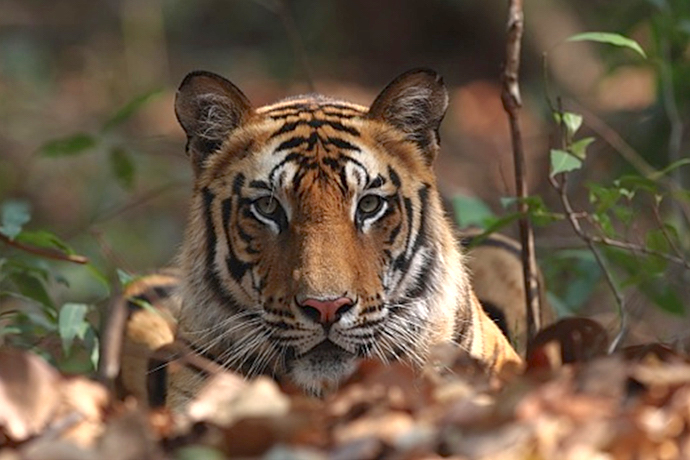The tigers of mythology, of legend, of stories from childhood are all embodiments of raw power – the quintessential tiger is a creature of great strength, unmatched ferocity and savage instinct. I have never seen a tiger fit the description as perfectly as the larger Mirchaini male sub-adult. He was the ultimate predator, who at one time would have been the undisputed king of the jungle, but in 2011 in Bandhavgarh, he became the unwitting protagonist of a tragedy written and directed by human beings.
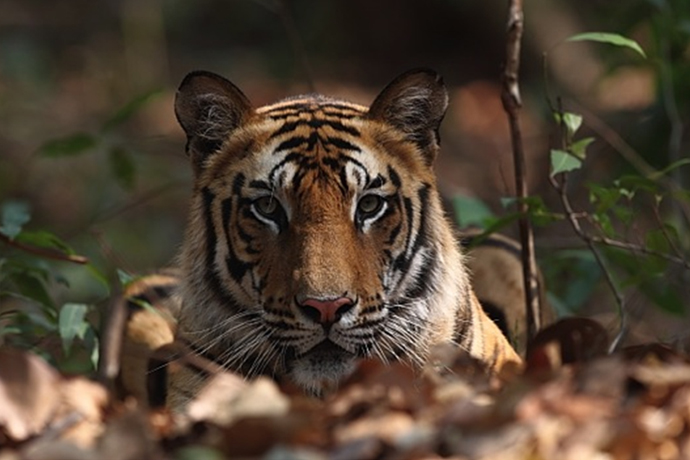
Born in 2009 to the Mirchaini female and B2, he was one of a litter of three, two brothers and a sister. I first saw his brother in May 2010, but didn’t see him till my second trip in April 2011. On the very first day, as we were approaching the Mirchaini area, we came upon the two male sub-adults on the road in front of us. The smaller male sat down, and I noticed porcupine quills stuck in his chest, but the larger male, simply walked away from us and out of sight. The powerful grace of his walk struck me, but then tigers are always a sight to see, so I just thanked my stars I’d been able to see two together on my first day there. I didn’t know then how gripping my fascination with this one individual would become.
The next sighting I want to write about was my closest encounter with this male and perhaps any tiger. We were approaching the PatparraNallah, a small gully through which the road would pass, when we began to hear alarm calls. Dawn had broken a few minutes ago, and the early morning light bathed the April landscape. Deer were looking down into the nallah and the calls, theirs and the langurs’, were intensifying, so we continued down the road and stopped directly in the middle of the gully. And then it happened. From just around a bend to our right, in all his grandeur, emerged the larger Mirchaini male, no longer a cub, but an almost fully-grown splendid young tiger.
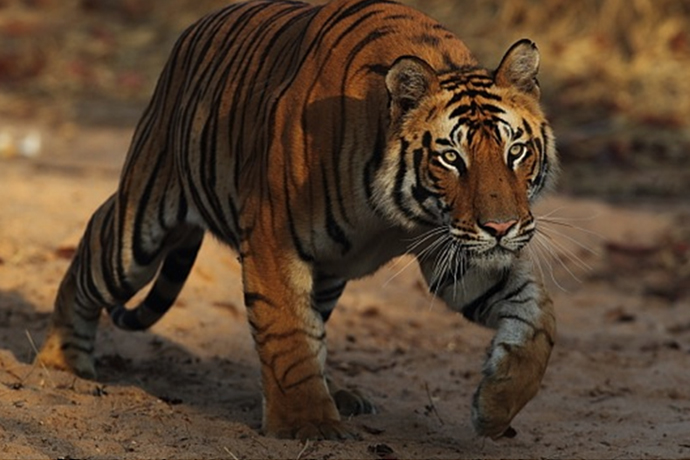
He walked directly towards us in a low crouch, almost stalking the jeep, investigating this intrusion into his territory, getting closer all the while. From behind the lens, the only thing that mattered to me at all was what was in that viewfinder. The tiger was 20m, 15m, 10m away, and I was firing shot after shot. Effectively, that meant the growing danger of being stalked like prey by an aggressive young male tiger was entirely lost on me. Any closer and I could’ve been tiger fodder and this article would never have been written! Luckily, he decided to stop his advance, and sat down on the sand, gazing first at us and then at the deer on a nearby hillock. Suddenly, from outside the nearby boundary fence, a dog barked, the tiger turned and I kept clicking. He bounded up the walls of the naalah, and was soon lost from sight. It was only a matter of minutes, but I came as close as I ever would to photographically capturing the essence of this inimitable creature. Alarm calls told us the other two siblings were probably around the bend as well, but they chose to stay hidden, and after a while we moved on.
If that encounter gave me the best tiger pictures I’ve taken yet, undoubtedly the most exciting sighting came a few short days later. I myself was lucky, but the lesson I learned stands valid – never leave a tiger sighting, because you never know what may happen next. There was a crowd of 10-12 jeeps lined up next to the fence, and on the other side, about 100m away, lay the two males, lounging together in the meadow, looking half asleep. We stood and watched, but they seemed disinterested in everything but basking in the sunlight, too far away to click. Hearing a report of an early morning B2 sighting nearby, we took off from the spot to try and see him ourselves, but it seemed our luck had failed us. Little did we know what was in store for us– for what I got to see that day, I would’ve given up a regular sighting without batting a tiger-mad eyelid.
Our little foray having been unsuccessful, we were returning to the area with the boundary fence, and ended up last in the long line of 17-18 jeeps, not expecting to see much. But the atmosphere swiftly turned electric as we realized that a sambar was moving towards open ground, and the larger Mirchaini male’s eyes were fixated on it. I could see his muscles like coiled steel rippling under the surface of his skin, as he stealthily covered a large open area, inching ever closer to the deer. He waited just behind a tree, sandwiching the sambar between himself and the fence, never taking his eyes off it for a moment. As the sambar came within his ‘kill zone’, the tiger launched into a run, and the chase was on. I had leaped to my feet and was standing on top of the jeep holding my heavy camera with a heavier 300mm lens attached and firing away. I tried to keep the fence out of the frame, and my hand steady, and prayed fervently that at least some of the images would come out properly focused.
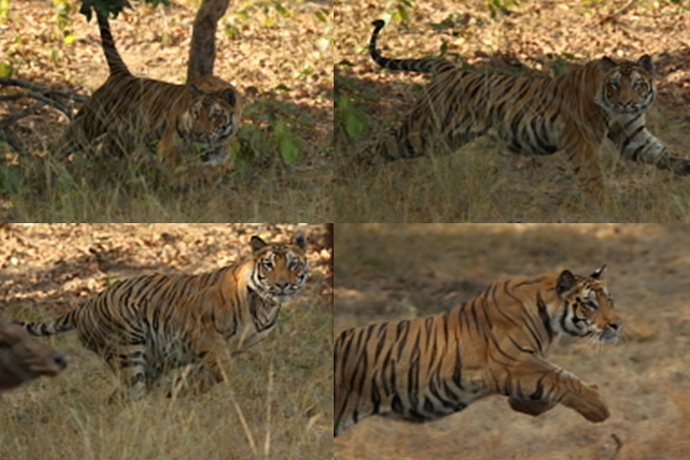
A cacophony of wows and foreign exclamations was exploding around me, but my attention was fixed on the hunt almost as firmly as the tiger’s on its prey. The stag ran for its life, racing along the fence past the entire queue of jeeps until it found its path blocked by a tree. This caused one tiny moment of confused hesitation, which was enough to seal its fate. The powerful predator closed the distance between himself and his prey in split seconds, and I realized then that the poor sambar had never even stood a chance. In one great leap he had it by the throat – and it was all over. The entire chase had lasted about 9 seconds, and I had timed pictures to prove it.
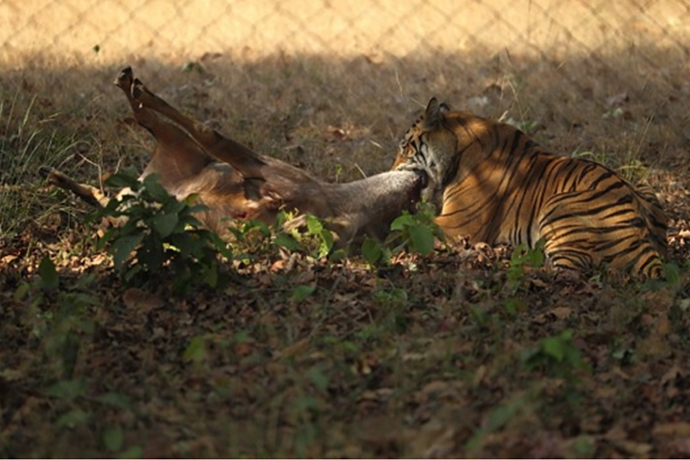
As soon as I saw him put down his prey, before anyone else even realized what had happened, I yelled to Yadavji to race our jeep ahead, and we sped past the never-ending queue in 45 seconds flat. My reward was the best seats in the house for a close-up view of the tiger’s vise-like grip on the sambar’s bloody throat. A British photographer in a jeep nearby brought in a dose of humor – he’d been so enthralled by the sight that he’d conveniently forgotten to take any pictures. But such was the magic of the moment. In 15 years I’d never before had the privilege of witnessing a successful hunt from start to end, and it took a long time to bring my heart rate back down to normal. The sheer exhilaration of watching such a display of raw power was incomparable.
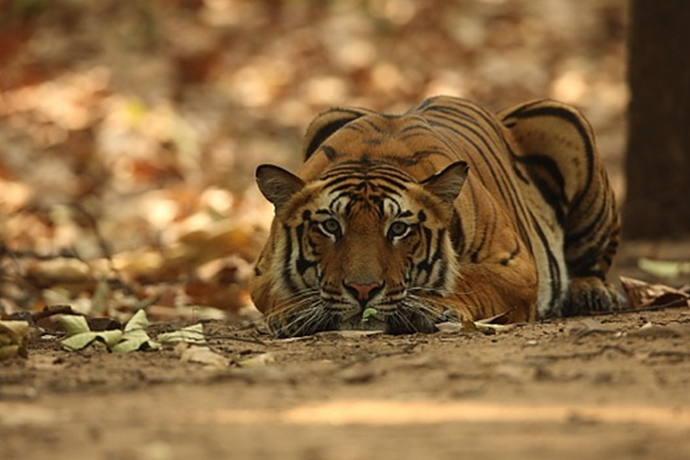
By this time the larger Mirchaini male had become my muse. We were lucky enough to have good sightings almost every day, but a few of them stood out for me in terms of the quality of pictures they yielded. Once, we were crossing a fire-line, a gap created between thickly wooded areas to help contain forest fires, when we spotted him. The fire-line he was following curved out of our field of vision, but we knew that it would be visible again from a spot further down the road. Taking the jeep there, we waited for the tiger to emerge. Sure enough, he soon came into sight, and finding a large log blocking his way, jumped over it to approach us. He sat down, staring as if he was ready to stalk us again, just like the last time. Fortunately or unfortunately, he spotted a deer on the other side of the fencing and chose to stalk it instead. He dropped into a characteristic crouch, chin to the ground, body bunched together. There was no chase or kill, but he gave me some beautiful shots anyway, and every incident that gave me a deeper insight into his personality made me a bigger fan.
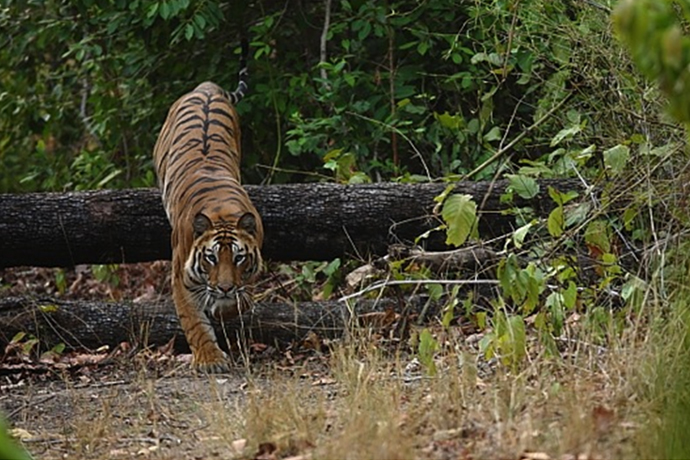
Another time, on a hot afternoon, by making use of my special permissions, we were waiting in an area the sub-adults were known to occupy. As we sleepily tried to drive away the flies that insisted on pestering us, there was a rustling of leaves, and through the undergrowth emerged my source of inspiration. He sat watching us warily, and as soon as I reached for my equipment, he dropped again into the same aggressive crouch. His aggression always made for excellent photographs, however. I wish I could say this picture shows him snarling angrily at me as I fearlessly stole the shot from the very jaws of death itself – but unfortunately this is a yawn. It was the first time I saw a standing tiger yawn – usually big cats yawn only after waking up, and always exactly 3 times. But I already knew this one was unique.
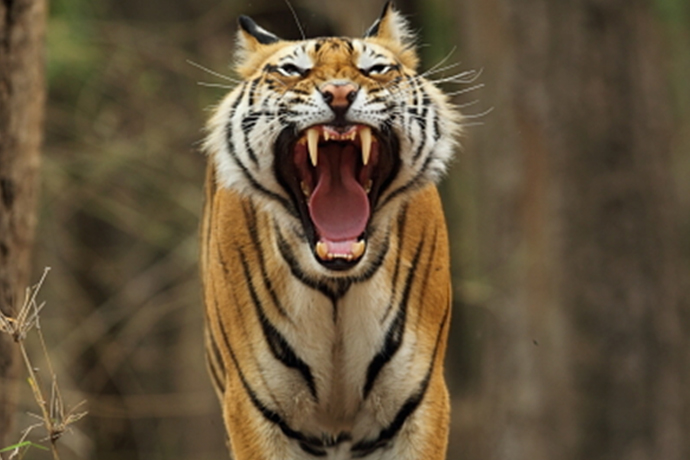
The three Mirchaini sub-adults stuck together, and looked out for each other. They were just two months short of adulthood in April 2011, and still almost always shared kills. In fact I even saw them sharing the sambar kill with their father, B2. The larger male was often protective of his siblings – whenever it came to investigating our intrusions, he would usually be the first to approach us. A few times we ran into the brothers walking along the road treating the jeeps as if they didn’t even exist.
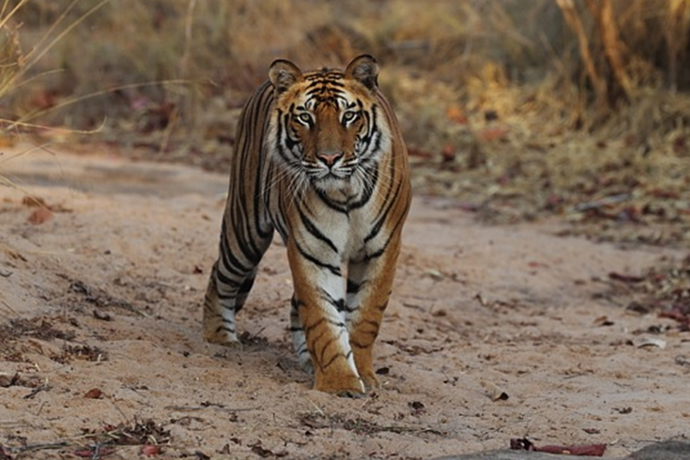
This particular tiger, the larger Mirchaini male, has been fixed in my imagination ever since then – he was a natural born killer if ever there was one, the perfect specimen of a ruthless predator. I have closely followed his life subsequently, and the vicissitudes of the man-tiger conflict could not play out in a sadder way.
Three human deaths took place in the Mirchaini territory between May and July 2011. On 23rd May, a woman collecting mahua leaves just outside theboundary fence was attacked and died of a neck injury, typical of a tiger killing prey. A man entered the area soon after this to empty his stomach, ignoring the warnings of the villagers, and was killed as well. Angry villagers chased the big cat from the bodies, but Forest Department officials were unsure as to which tiger was responsible for the deaths. On 7th July, an off-duty forest guard, SantoshYadav, was collecting bamboo at 5:30pm, when he was attacked and dragged about 400m into the forest. The search for his body was unsuccessful till the next day, when his bones and some clothes were found. His flesh had been consumed.
The NTCA put in place very specific guidelines about declaring big cats man-eaters as far back as 2007. There are three circumstances under which it is stated that the killings should be classified as accidental, out of which the third exactly fits the description of the events of May-July 2011:
“A bent-in posture by man when a tiger takes him to be an animal and attacks. In such cases, the tiger/tigress does not eat the dead person in the first case, but it may start eating the dead body if the tiger/tigress come across such accidents more than once. If the tigress is with cubs and is confined to a limited area with shortage of natural prey, she is more prone to eat the dead body. The mere fact that the dead body has been eaten does not prove that the animal is a man-eater. Similarly, the fact that a particular animal has killed more than one human being also does not prove it to be a man –eater. The circumstances under which the animal killed the human being has to be examined in detail to arrive at any conclusion.
If a tiger/panther begins to seek out, stalk and wait for human beings and has after killing a person, eaten the dead body, it is established beyond doubt that the animal has turned into a man-eater.”
As per the guidelines, it is very clear that these killings by the Mirchaini male sub-adults fell under this third category, and were therefore accidental. However, as the NTCA too acknowledges, every incident occurs under its own unique set of circumstances.The situation on the ground was a tinderbox, and knowing the Field Director CK Patil personally, I’m sure he weighed his options extremely carefully before arriving at a decision. Protests against the Forest Department had turned violent, and three officials had been injured. The pressure was mounting on the Forest Department to identify the tigers responsible for the deaths and take action– particularly since the villagers have a history of poisoningcattle-hunting tigers. The Field Director believed that the tigers of the Mirchaini area were in substantial danger, since three deaths would not be allowed to go unavenged. And so, the two Mirchaini male sub-adults were declared man-eaters, and the decision was made to transfer them away from Bandhavgarh, away from the wild free forests of their birthplace. They are now the newest residents of Van Vihar, also known as Bhopal Zoo.
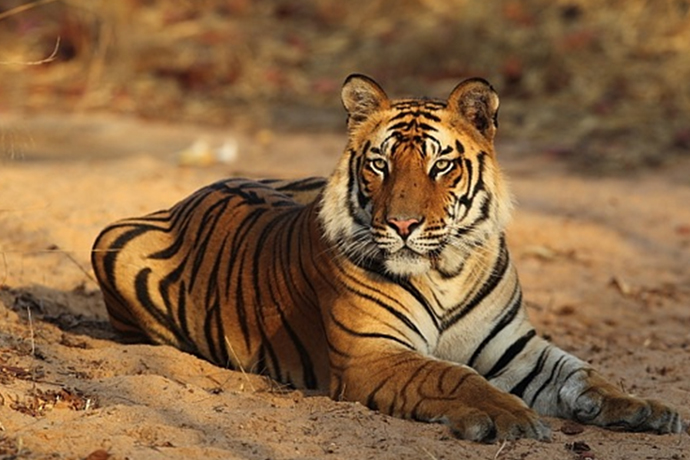
Jeremy Bentham said that the question is not, “Can they reason?” nor, “Can they talk?” but rather, “Can they suffer?” The Mirchaini males are now locked away in enclosures afraction of the size of their former territory, suffering.Their only crime? Man getting in their way. Incidents like these are quietly put away into a box labeled “Man-Tiger Conflict” and forgotten, but can we expect these tigers to simply forget the rest of their lives? This one tiger that has capturedmy attention, imagination and heart is a truly magnificent creature. All I hope is that this is not the end for him. He deserves to die, as he was born – free.
